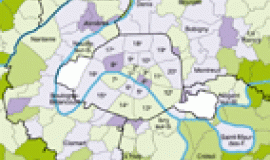
The Families Observatory has built up a database for observing families and how they evolve. A first report, written in 2007, clearly shows the principal developments in Paris such as the high birth-rate, the increased age of women giving birth and the outstanding number of single parent households.
A new report became necessary to present and interpret data gathered between 2006 and 2009. Compared with the first, the second, 2010 report has made a lot of headway:
- It has the advantage of longer statistical series, and above all data from the 2006 population census which permitted numerous structure indicators to be updated.
- It takes better account of the metropolitan dimension and throws light on the social and demographic progression beyond the Parisian ring-road -Boulevard Périphérique- through cartography which encompasses the entire urban agglomeration.
The 2006-2009 data shows the continuing evolution of certain aspects of Parisian families but also the emergence of new trends.
An important recent development is the rise in the number of families. In 2006 there were 254,000 families with at least one child under 25 living in Paris; 10, 000 more than in 1999, that is to say an increase of 4,1%.
As a consequence the number of families in Paris is once again, what it was at the beginning of the 1980s. This increase is consistent with the general rise of the population, except that in Paris it has risen slightly more quickly ( an average of +0,6% per year, compared with 0,4% for the population as a whole).
This slight increase particularly involves families with two or more children (+9,300 families from1999 to 2006). The growth in the number of families concerns all the central areas of the Parisian urban agglomeration: it is in the Haut-de-Seine (+17,800 families) and the Seine-Saint-Denis (+17,400) where they have increased the most. On a wider scale the Ile-de-France Region acquired 76,000 families between 1999 and 2006, the majority being in the four central, Departmental, administrative divisions of the agglomeration (+54, 000 families).
In terms of family profiles the number of single parent households continues to go up . In Paris, it rose to 70,000 in 2006, an increase of 7000 family units since 1999. The portion of single parent families in the total number of families has therefore grown: reaching 27,6% rather than the 25,8% in 1999. The increase was, however, less marked between 1999 and 2006 in Paris than in other areas of the territory, single parent families already being strongly represented in the capital.
Following a period of growth between 1997 and 2002, the number of registered births, domiciled in Paris saw a gradual, although uneven, decline after 2002, reaching 30,623 Paris domiciled births in 2008. This slight drop (- 0.5% between 2002 and 2008) contrasts with developments in the Region (+4,1% over the same period) and nationally (+4,5%).
Another observation, the average age of parents at birth has continued to go up. The average age of mothers giving birth was close to 32 in 2008 in Paris, compared with 31 in 2000. More and more parents have children over the age of 37. Their percentage in the total number of births continued to rise almost constantly between 2002 and 2008. In 2008 15% of mothers of babies born were over 37 years of age. The same goes for fathers , 33% were over 37 in 2008. The same trends can be observed at a Regional and national level but to a lesser degree.
The socio-economic situation of families, in terms of the socio-professional activity, and income, is on average more favourable in the capital, where a greater and increasing proportion of managerial staff and skilled jobs are concentrated, than on a national level.
Families where the household reference person has a managerial job make up 40% of Parisian families (36% in 1999). This is proportionally much higher than in the Ile-de-France (27% of families in 2006, 24% in 1999) and in France (17% of families in 2006, 14% in 1999). This reflects the distribution of socio-professional categories among the Parisian population (41% of Parisians hold managerial posts).
Parisian families declare a higher average income than the national average. According to data from the tax authority -Direction générale des impôts –, the average, declared income, (before tax allowance) of household tax units with children was 62,800 euros in Paris in 2006 compared with 44,300 euros in the Ile-de-France Region and 34,600 euros in France as a whole.
Averages should not hide the extreme differences in income which exist between families. According to data from the Paris Social Security and Child Benefit Office -Caisse d’allocations familiales de Paris – 52,000 families, that is to say 20,6% of Parisian families lived on less than the low income threshold in 2008. This rate was fixed at 900 euros per consumption unit. However the proportion of poor families is far higher in the 18th and 19th districts where approximately one family in three is beneficiary of a low income (respectively 36% and 33%). Globally speaking poorness is most common in single parent households (39,3% of them are poor) and among families with three or more children (27% are poor). The most unfavourable situation is single parents as head of families with three or more children: over half of them (53,6%) live below the low income threshold.
In that concerning work, the proportion of dual income households (1) has increased more on a national level than in the capital. In 2006, the portion of dual income households was not quite as high in Paris as in France as a whole (75.6% of couples with children in Paris, 77,1% in France). The growth rate seen in the inner suburbs and on a Regional level are slightly higher than that within Paris (76% in the inner suburbs, 77,5% in the Ile-de-France Region).
Recent data indicates that the strongest signs of tension are consistently linked to housing in Paris. The size of Parisian homes is the first barrier to accommodating families. Flats with 4 rooms or more represented only 20.1% of housing available in 2006. This percentage remained stable between 1999 and 2006 and is still much lower than those found in the Ile-de-France (41.1%) and France (57.4%).
The restriction is also financial: the high cost of property and rents is a major draw back for families. In 2009 the average selling price for old flats was 5,689€ per square metre in Paris. After paying the solicitor's fees, the average price of a 90 m² Parisian flat was over 510,000€ in 2009, that is to say twice as much as that of an individual house in the Seine et Marne. Similarly, the average rent for an apartment is much higher in Paris (19,0€/m²) than in the inner suburbs (14,5€/m²)or the outer suburbs (12,4€/m²).
In this context social housing -parc social- is a determining factor when housing families. In 2006, one Parisian family in four (25%) were tenants of social -HLM- housing as opposed to one out of six families in the provinces. In the inner suburbs the level of tenant families in social housing is the highest (34% in 2006). The proportion of single parent households is particularly high (35% of them live in social housing) as is the proportion of families with four or more children (47%). The portion of home owning families (33%) grew between 1999 and 2006 (+4,5 %) but remains far below Regional and national levels.
The marked presence of families in social housing -parc social- emphasises the huge demand for family housing. In 2009, 44,351 families, that is to say 17% of Parisian families were registered on the Parisian files of people demanding social housing. Among families, those most likely to go through the procedure of making a demand were large families (37%) and single parent households (39% ).
Faced with the high demand of families the size of social housing units created became an important factor. The portion of social housing registered endowed with 4 rooms or more has grown since 2001, going from 19% to 24% in 2005, with however fluctuating regularity from one year to the next. A total of 6,509 social family housing units with four rooms or more were approved over the period, that is to say 24% of the total number of housing units registered.
Within this context, large families benefit from housing subsidies from the Council. In 2009, the benefits: '”Paris Family Housing” -Paris Logement Familles- involved 23,000 families and “Paris Single Parent Family Housing” -Paris Logement Familles Monoparentales- nearly 7,000 families. The number of beneficiaries of this aid more than doubled between 2002 and 2009.
In 2008 the Paris Social Security and Child Benefit Office -Caisse des allocations familiales de Paris- came to the help of almost 54,000 families by allocating housing benefits, that is to say 21% of Parisian families. Half of these families live in social housing (26,489) and receive the housing benefit -aide personnalisée au logement (APL)-the other half (27,125 families) receive the housing benefit -allocation de logement (AL)-. The number of families receiving the APL increased by 18% between 2001 and 2008.
The Observatory report also includes statistical data relating to family services and facilities. In the way of early childhood care Paris offers quite an extensive and continually evolving range of council run, (collective and family) day-nurseries -crèches- and part time child care centres -haltes-garderies-. Between 2005 and 2009 the number of places and structures for collective childcare for children of under 3 went from 25,819 to 29,199 in 2009, an increase of +13% in 4 years. This rise bears witness to public authorities' determination to address the high demand which is linked, among other things,to the rise in the birthrate. So far as individual care goes, Paris can be noted for the limited use of registered child minders -assistantes maternelles- due to the limited space in their homes. On the other hand children being looked after in their own homes is particularly frequent and continues to develop in the capital.
In terms of school population, after a rise during the period 2001-2005, the number of pupils enrolled in schools slightly decreased between 2005 and 2009. Globally speaking, counting the total number of pupils in state and private schools of all levels and types of establishments the number of pupils in school, resident in Paris has diminished by 845 pupils, whereas it had risen by 3,256 between 2001 and 2005. However, these developments differ according to the level of schooling. In pre- elementary schools the marked slowing down of attendance is linked to the demographic decrease. In primary schools numbers are going up after a long period of them falling. At middle school -collège-,the number of pupils has been going down but the trend should change in the 2010 school year, due to the arrival of a more abundant generation. In high schools – lycée- numbers of pupils have also been dropping. The proportion of Parisian pupils in private schools is diminishing at pre-elementry and elementary levels but increasing at middle and high sschool -collège and lycée- levels. In 2009 the private sector represented 30% of pupils enrolled at middle school -collège-, 25,4% at high school – lycée- level, 22,6% at primary school and 16,3% at infant school.
In Paris in 2008-2009 over 109,000 Parisian children had school lunches every day, in school refectories in the capital. The proportion of day boarders has increased from 72,5% in 2001-2002 to 80% in 2009-2010. The rate of attendance at supervised study periods and tea-time snacks in infant schools also increased between 2001 and 2009 from respectively 22% to 24% and from 30% to 31%. Leisure activities data shows that attendance at leisure centres clearly went up between 2005-2006 and 2008-2009. In 2008-2009, 26,700 children (17% of school children) went to leisure centres regularly on Wednesdays and approximately 20,000 (15% of school children) during the short holidays (in autumn,winter and spring 2008-2009).
The City of Paris is, at last, offering financial support to Parisian families in the form of the benefit -Paris Forfait Famille- (involving nearly 5,000 large families in 2005, over 20,000 families in 2009 and family aid for electricity -Avantages EDF aux familles- (33,150 families effected in 2009) are two of the recent aids set up by local councils.
To conclude, one can see that one of the principal recent results is the rise in the number of families. The analysis shows that this increase is not uniquely a Parisian phenomenon but well and truly a phenomenon of the heart of the urban agglomeration, with particularly marked growth in the Departments of Seine-Saint-Denis and Hauts de Seine. The second point concerns the rise in the cost of property and rents which have weighed heavily on Parisian families in recent years and to which was added the financial crisis at the end of 2008. Even if the most recent data does allow the exact impact of the crisis to be measured, the economic and social context is becoming more and more difficult. Under these circumstances, the system of aid for families (social, housing, leisure activities …) most certainly plays a role in keeping them at the heart of the urban agglomeration.
(1) by dual income households we are referring to couples with at least one child aged under 25.




